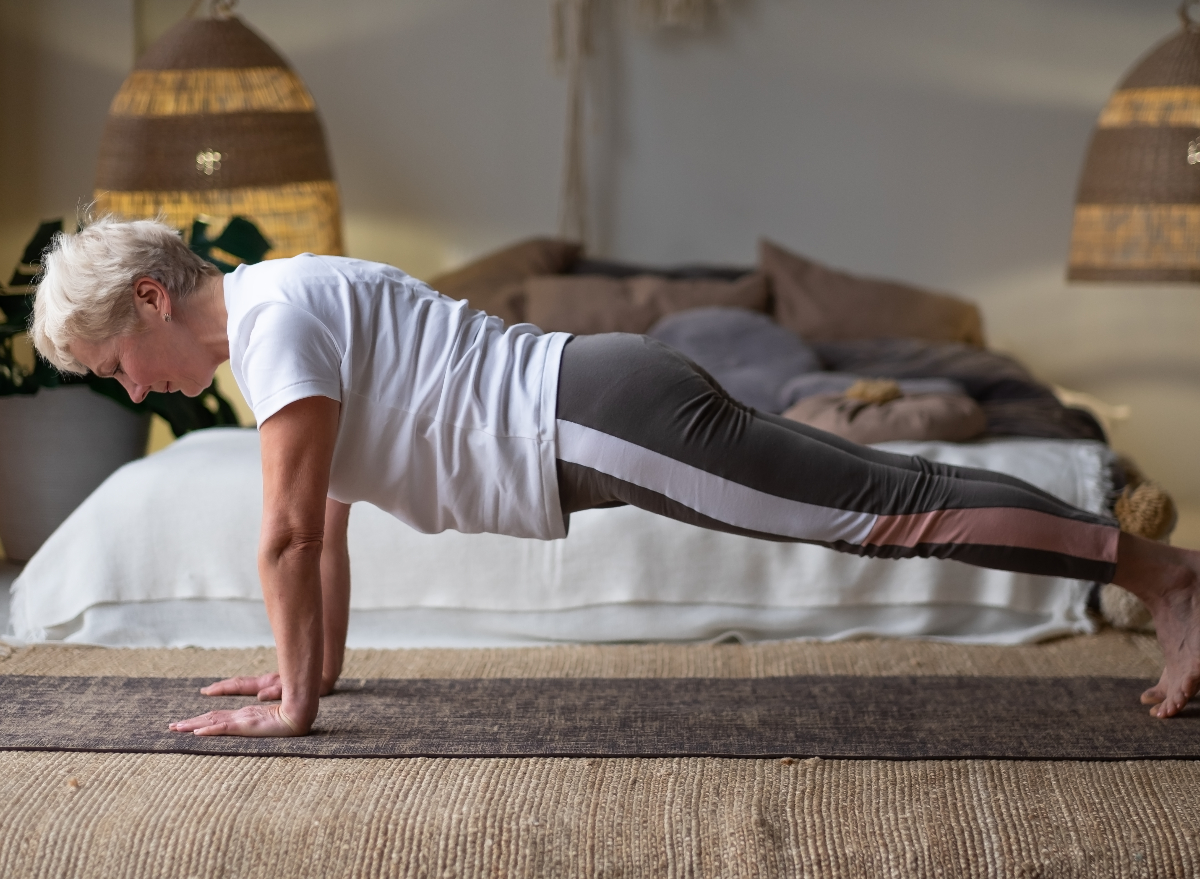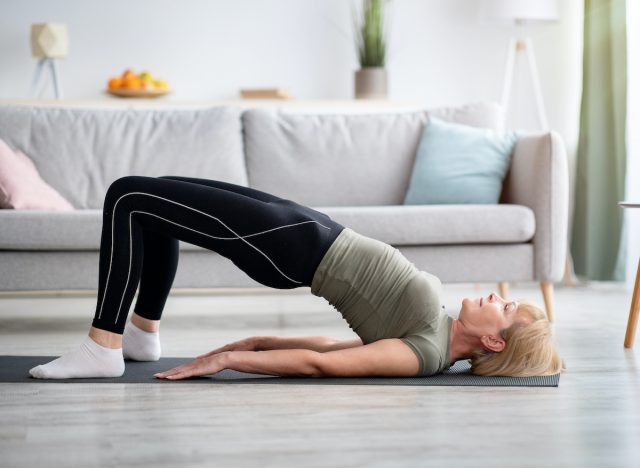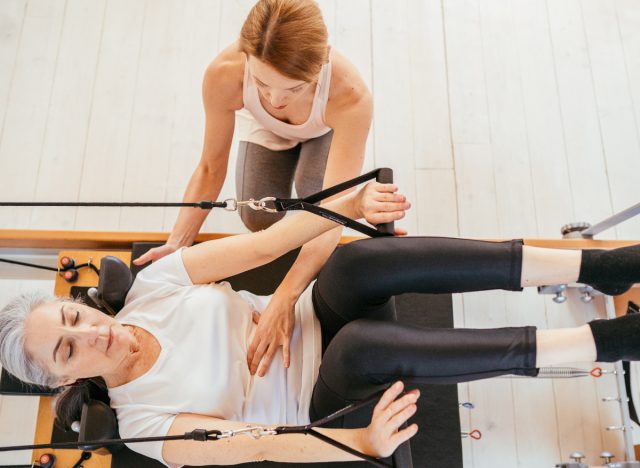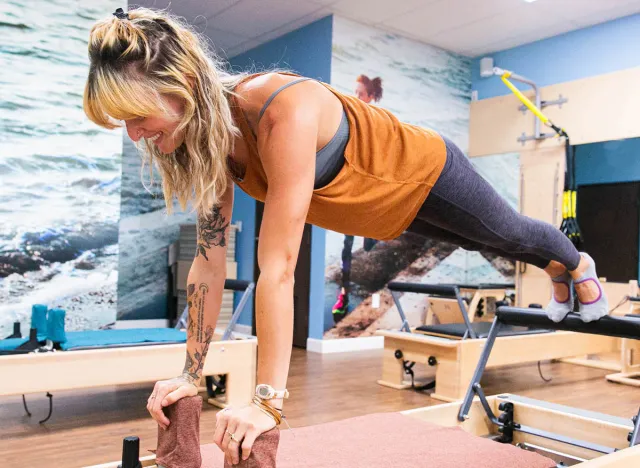6 Exercises You Need To Do Regularly in Your 60s To Stay in Shape

Growing older means tweaking your fitness routine. How so? Well, you want to ensure you’re doing just the right exercises that keep you strong, maximize your goals, and help you avoid potential injury. We linked up with Juanita Franke, lead instructor at Club Pilates Charlottesville, who shares six exercises to do regularly in your 60s so that you’re in the best shape.
“The Pilates reformer, when used with the supervision of a certified Pilates instructor, is an incredible apparatus and tool for people of senior age,” Franke explains. “It’s designed to safely create resistance and stability for the user, with the intention of strengthening and lengthening the muscles, supporting the joints, and strengthening the core.”
The below exercises can be done with variations, depending on which modifications your body needs. And if you don’t have access to a Pilates reformer, these moves can also be done on a mat! Keep reading to learn all about them, and next, check out 5 Strength Exercises That Drastically Change Your Body Shape After 50.
Bridging

This exercise is stellar for your posterior chain, glutes, and core. “Bridging will build strength through the core, glutes, and hamstrings while increasing mobility of the spine,” Franke adds.
You’ll start by lying on your back and bending your knees. Once again, your feet should be a bit closer together than hip-width distance apart and pretty close to your buttocks. Then, tilt your pelvis back toward your torso, bringing your hips off the floor. Inhale at the top of the motion, and come back down. Repeat three to five times.
Footwork
“Footwork is excellent for working the intrinsic muscles of your foot as well as the alignment of the whole leg,” Franke explains. “This work improves balance, gait, and core stability.”
This first exercise will have you lying flat on your back on the Pilates reformer. Your heels should be on the foot bar, a bit closer together than hip-width distance apart, with three or four springs on. Breathe out as you completely extend your legs. Then, take a deep breath in as you bring the reformer carriage back in, keeping your spine neutral. Repeat this exercise eight to 10 times. Feel free to tweak your foot position by moving into the arches of your feet or even your toes.
Supine Arms

Now, let’s move on to supine arms. “Supine arms bring mobility to the shoulder joint while increasing core stability against that movement,” Franke says.
Lie down on your back on the Pilates reformer with two springs on. Put your hands through the tiny loops, positioning your arms perpendicular to your shoulders. Your legs should come into a tabletop position while you keep your spine neutral. Exhale, and bring your arms to your hips, making sure each arm stays straight through the wrist and elbow. Take a deep breath in as you return your arms to the top. Repeat four to six times, making sure there’s light tension in your abs.
Plank

You’re likely familiar with this classic exercise—the plank! This is another move that’s awesome for building up stability through your core muscles, your shoulders, and your hips, according to Franke.
You’ll start off on all fours. Your wrists should be underneath your shoulders and your knees should be aligned with your hips. Franke continues to explain, “Tuck your toes under, engage your core, press into your feet, and hover your knees about an inch off the ground. Step one foot back at a time to fully extend the legs into your plank. Think of pushing the floor away from you through the hands and tightening the glutes. Hold for as long as you can stabilize the position.”
Mermaid
It’s time for the mermaid. You’ll begin sitting sideways on the Pilates reformer. If you’re able to, feel free to sit in a “Z-sit position,” bringing one foot back against the reformer’s shoulder blocks. If you can’t sit comfortably that way, position your legs in front of your body, and let them move with the carriage.
“Bring one hand slightly in front of the shoulder on the foot bar. Press into the hand, straightening your arm and sending your rib cage toward the footbar. As the carriage moves away from the footbar, send your other arm up and over the body for a side stretch. Try to leave your hips heavy on the carriage to increase the stretch. Straighten yourself back to sitting as you control the carriage back into the stopper. Notice the mobility in your spine, rib cage, and shoulders. Try to gently engage the obliques as you return to sitting,” Franke instructs.
Swan
Last but not least, let’s do the swan. This exercise will activate the muscles in the back of your body, which will give your posture a nice boost.
Lie on the ground flat on your belly with your legs out straight and your hands placed right below your shoulders. Extend your legs as if you’re pushing them away from your body, activating your hamstrings and your glutes in the process. From there, Franke says, “Slowly press your weight into your hands, sliding your shoulders down your back as you lift your chest away from the floor. Tuck your chin to keep a long neck, and broaden your collarbone.”









